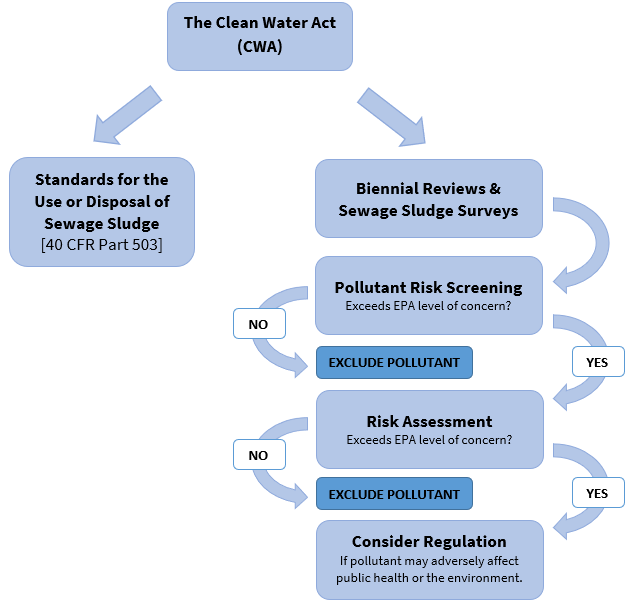Biosolids Laws and Regulations
How Biosolids are Regulated
The Clean Water Act (CWA) of 1972 and its amendments govern water pollution in the United States and are central to EPA’s mission to protect public health and the environment.
- Summary of the Clean Water Act
- Federal Water Pollution Control Act (Clean Water Act) (PDF) (234 pp, 1 MB, About PDF) – Section 405 Begins on Page 205
Section 405(d) of the CWA requires EPA to:
- Establish numeric limits and management practices that protect public health and the environment from the reasonably anticipated adverse effects of chemical and microbial pollutants during the use or disposal of sewage sludge.
- Review sewage sludge (biosolids) regulations every two years to identify any additional pollutants that may occur in biosolids, and then set regulations for those pollutants if sufficient scientific evidence shows they may harm human health or the environment.

Standards for the Use or Disposal of Sewage Sludge (40 CFR Part 503)
Per the first requirement of CWA section 405(d) which requires EPA to establish requirements and management practices for the use and disposal of sewage sludge (biosolids), EPA issued the regulations found in 40 CFR Part 503.
40 CFR Part 503, Standards for the Use or Disposal of Sewage Sludge, regulates sewage sludge that is applied to land, fired in a sewage sludge incinerator and/or placed on a surface disposal site. It includes pollutant limits, requirements for pathogen and vector attraction reduction, management practices, monitoring, recordkeeping, and reporting among other requirements. 40 CFR Part 503 applies to any person or treatment works that prepares sewage sludge, applies sewage sludge to the land, fires sewage sludge in an incinerator, and the owners and operators of surface disposal sites.
- Code of Federal Regulations: 40 CFR Part 503, Standards for the Use or Disposal of Sewage Sludge
- Federal Register (Includes Preamble): Standards for the Use or Disposal of Sewage Sludge; Final Rules
- A Plain English Guide to the EPA Part 503 Biosolids Rule
EPA’s A Plain English Guide to the EPA Part 503 Biosolids Rule summarizes 40 CFR Part 503. While the guide is not a substitute for the actual rule, it is consistent with the content of the Part 503 rule and can be a helpful tool.
Process for Regulating Pollutants in Biosolids
The CWA also requires EPA to review sewage sludge (biosolids) regulations every two years to identify any additional pollutants that may occur in biosolids and then set regulations for those pollutants if sufficient scientific evidence shows they may harm human health or the environment.
- Biennial reviews are conducted to identify publicly available data on previously and newly identified pollutants in biosolids. Reports are published every two years with data that may be used to conduct risk assessments on pollutants found in biosolids.
- Sewage sludge surveys identify pollutants in biosolids from wastewater treatment plants (WWTP).
- EPA will screen those pollutants found in biosolids to identify which pollutants do not pose a risk and which exceed EPA’s levels of concern. A pollutant risk screening process increases EPA’s ability to invest more resources into pollutants that potentially present greater risk to human health and the environment.
- Risk assessments will be conducted on pollutants identified in biosolids that exceed a level of concern to determine if those pollutants pose harm to human health and the environment. EPA may regulate those pollutant that pose risk.
Regulatory Determinations for Pollutants in Biosolids
For more information on the regulatory determinations made for pollutants found in biosolids, visit the following page:
Compliance
EPA and states can issue permits for biosolids management. For example, some biosolids permits are issued through the National Pollutant Discharge Elimination System (NPDES).
40 CFR Part 503 is a self-implementing rule. This means that the requirements of Part 503 must be met even if a permit has not been issued. An enforcement action can be taken against a person or wastewater treatment plant (WWTP) who does not meet the requirements of Part 503 even when that person or WWTP does not have a permit for the use or disposal of sewage sludge.
National Pollutant Discharge Elimination System (NPDES)
The NPDES program oversees and regulates the discharge of pollutants into waters of the United States. A NPDES permit translates general requirements of the Clean Water Act into specific provisions for a person or WWTP discharging pollutants into water to protect human health and the environment. Components of the NPDES program include the biosolids program, state NPDES permits, regulation of federal facilities, the pretreatment program, and the general permits program. States may receive authorization to run one or more of the NPDES program components. To date EPA has authorized eight states to implement the biosolids program as part of their NPDES program.
Annual Biosolids Reporting
Certain treatment works specified by Part 503 are required to submit an annual report on biosolids treatment and management practices to their permitting authority by February 19th of each year. Additional information is available including annual reporting requirements, frequently asked questions, and training webinars.
Pretreatment
The goal of the Pretreatment Program is to prevent the introduction of pollutants into publicly owned treatment works (POTWs) which will pass through or interfere with the operation of a POTW, including use and disposal of biosolids.
Suspected Noncompliance?
Please contact EPA Biosolids Center of Excellence and/or your regional and state biosolids coordinator if you suspect noncompliance at a wastewater treatment plant, sewage sludge incinerator, land application site, or surface disposal site.
- Contact EPA Biosolids Center of Excellence (R7_Biosolids_Center@epa.gov)
- EPA Regional and State Contacts for Biosolids
